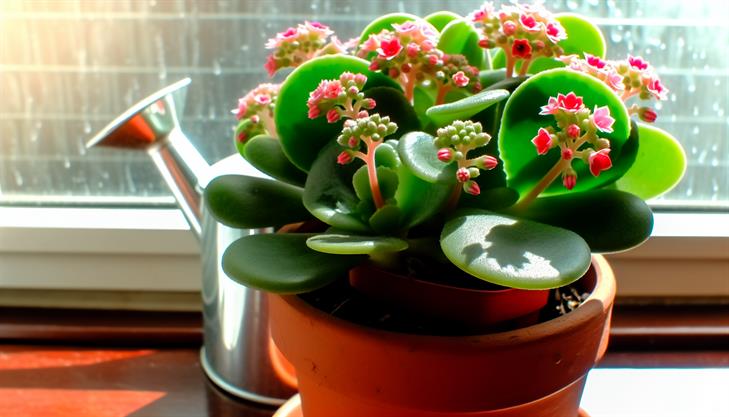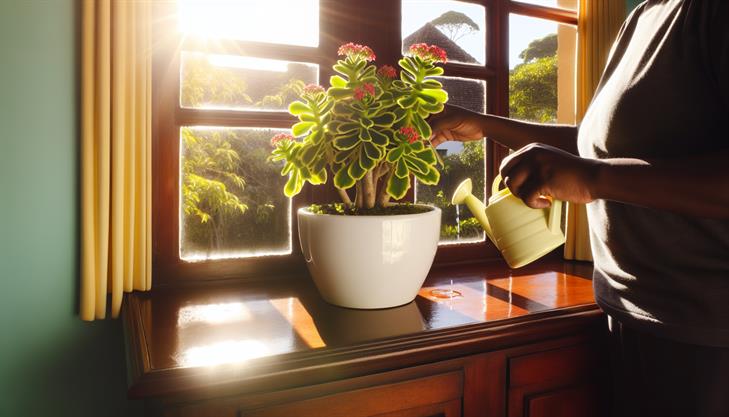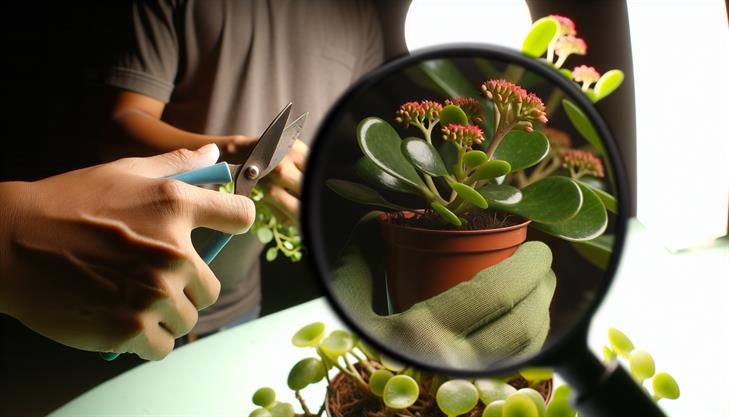In the enchanting world of indoor gardening, the Kalanchoe plant stands out as a vibrant gem, celebrated for its lush foliage and clusters of vivid blossoms. This succulent’s low-maintenance nature and striking beauty make it an ideal companion for both seasoned green thumbs and budding plant enthusiasts. However, to truly unlock the potential of this botanical marvel, it’s essential to understand its unique needs. Whether you’re hoping to add a splash of color to your windowsill or seeking a lively addition to your office desk, learning how to care for a Kalanchoe plant is crucial for keeping it healthy and flourishing. In this guide, we’ll walk you through the vital steps of nurturing your Kalanchoe, ensuring it remains a cheerful fixture in your home all year round. Join us as we delve into the essential tips and tricks that will transform you from a plant owner to a Kalanchoe connoisseur, proving that even the simplest care regimes can yield the most dazzling results.
Understanding Kalanchoe Plant Basics
Caring for a Kalanchoe plant involves understanding its basic needs to ensure it thrives indoors or outdoors. This popular succulent is known for its beautiful, long-lasting blooms, requiring minimal upkeep, making it ideal for beginner gardeners. Here’s a step-by-step guide on how to care for a kalanchoe plant:
1. Choosing the Right Environment
Light Requirements
Kalanchoe plants thrive in bright, indirect sunlight. Position your plant near a south-facing window to provide it with adequate light, but avoid direct sun exposure which can scorch its leaves. If growing outdoors in warmer climates, place the kalanchoe in partial shade.
Temperature and Humidity
Kalanchoe plants prefer temperatures between 60-85°F (15-29°C). They are sensitive to cold and should be protected from temperatures below 50°F (10°C). Maintain moderate humidity levels; high humidity can lead to fungal issues while extremely dry conditions can inhibit growth.
2. Watering Your Kalanchoe
Kalanchoe plants prefer a "soak and dry" method. Water the plant thoroughly, allowing water to drain from the bottom, and then let the soil dry out completely before the next watering. This prevents root rot, a common issue with succulents. Typically, watering every two weeks in warmer months and once a month in winter suffices.
3. Potting and Soil Needs
Soil
Use a well-draining potting mix specifically formulated for succulents or cacti. This type of soil prevents water from accumulating at the roots, which can lead to rot.
Pot Selection
Choose a pot with drainage holes. Terracotta or clay pots are excellent choices as they allow moisture to evaporate more effectively than plastic pots.
4. Fertilizing for Optimal Growth
Fertilize your kalanchoe plant once every two months during the growing season (spring and summer) with a balanced, water-soluble fertilizer at half strength. Avoid fertilizing in fall and winter as the plant enters its dormant phase.
5. Pruning and Deadheading
Regular pruning helps maintain the plant’s shape and encourages new growth. Remove spent blooms and dead leaves to promote more vigorous flowering. Use sterilized scissors to prevent disease spread.
6. Handling Common Issues
- Leaf Drop: Often caused by overwatering or sudden temperature changes. Adjust watering habits and stabilize temperature conditions.
- Pest Infestations: Watch out for mealybugs or aphids. Treat infestations with insecticidal soap or neem oil.
- Powdery Mildew: Ensure proper air circulation around the plant and reduce humidity levels to prevent this fungal infection.
7. Encouraging Reblooming
To encourage reblooming, ensure the plant experiences shorter daylight hours in the fall, mimicking its natural environment. Place it where it receives no more than 8-10 hours of light daily during this period.
Additional Advice
Consider propagating kalanchoe from cuttings to enjoy more plants or share with friends. Simply cut a healthy leaf or stem and allow it to callous over before planting it in soil. Additionally, always handle your kalanchoe with care, as it’s slightly toxic to pets if ingested.
By following these care tips for your kalanchoe plant, you can enjoy its vibrant flowers and attractive foliage with minimal effort. Regular attention to its environment and watering needs will keep your kalanchoe healthy and blooming beautifully throughout the seasons.
Essential Watering and Lighting Tips
Kalanchoe plants, known for their vibrant blooms and easy maintenance, are a popular choice among plant enthusiasts. Proper watering and lighting are crucial for keeping your kalanchoe healthy and thriving. Here’s a detailed guide on how to care for a kalanchoe plant.
Watering Tips
-
Moderation is Key: Kalanchoes are succulent plants, which means they store water in their leaves. Therefore, they prefer their soil to dry out completely between waterings. Overwatering is a common issue that can lead to root rot. To prevent this, check the soil moisture by inserting your finger about an inch deep. If it feels dry, it’s time to water.
-
Watering Schedule: Typically, watering every two weeks is sufficient, but this can vary depending on the climate and season. During winter, reduce watering frequency as the plant enters dormancy and requires less hydration.
-
Proper Drainage: Ensure that your kalanchoe is planted in a pot with drainage holes. This helps excess water escape, preventing waterlogging. Use a well-draining potting mix, ideally one designed for succulents, to further aid in drainage.
Lighting Tips
-
Bright, Indirect Light: Kalanchoes thrive in bright, indirect sunlight. Place your plant near a west or south-facing window for optimal light. Direct sun can be too intense and may cause leaf scorch.
-
Adjust Lighting as Needed: If you notice legginess (stretched stems with fewer leaves), it may indicate insufficient light. To remedy this, move your plant to a brighter location. Conversely, brown edges on the leaves might suggest too much direct sunlight.
-
Artificial Lighting: If adequate natural light is not available, especially during winter months, consider using a grow light to supplement. Position the light about a foot above the plant and provide 12-14 hours of light per day.
Additional Care Tips
-
Temperature and Humidity: Kalanchoes prefer a warm environment between 60-85°F (15-29°C). Keep the humidity low to moderate, as excessive humidity can cause fungal diseases.
-
Pruning: After the blooming period, prune any spent flowers and overgrown stems. This encourages new growth and helps maintain the plant’s shape.
-
Fertilization: Feed your kalanchoe every few months with a balanced, water-soluble fertilizer during the growing season (spring and summer). Reduce feeding during fall and winter.
-
Common Problems: Be on the lookout for mealybugs and aphids, which are common pests. Treat infestations promptly with insecticidal soap. Yellowing leaves can indicate overwatering, while limp leaves may suggest underwatering.
By following these essential watering and lighting tips, you’ll ensure your kalanchoe plant remains vibrant and healthy. Caring for a kalanchoe plant involves understanding its specific needs and adjusting your routine as necessary to create the perfect environment for its growth.
Soil and Fertilization Secrets for Thriving Growth
Caring for a Kalanchoe plant requires understanding its natural habitat and requirements to ensure flourishing growth. Here’s a comprehensive guide on how to care for this popular succulent:
1. Choosing the Right Environment:
Kalanchoe plants thrive best in bright, indirect sunlight. Place them near a sunny window where they receive plenty of light but are protected from the intense midday sun, which may scorch the leaves. Inadequate light can result in leggy growth.
2. Proper Potting and Soil Requirements:
Opt for a well-draining soil mix to prevent root rot, a common issue for Kalanchoe plants. A succulent-specific soil mix or a combination of regular potting soil with sand or perlite is ideal. Ensure the pot has drainage holes to facilitate excess water drainage.
3. Watering Schedule:
Overwatering is a frequent problem with Kalanchoes. Water the plant thoroughly, letting the soil dry out completely between waterings. During the growing season (spring and summer), this might mean watering every week or two. In the fall and winter, reduce watering significantly as the plant’s growth slows down.
4. Fertilization Tips:
Fertilize your Kalanchoe plant sparingly. Use a balanced, water-soluble fertilizer once a month during its active growing seasons in spring and summer. Avoid fertilizing in the dormant fall and winter months to prevent nutrient buildup, which can harm the plant.
5. Temperature and Humidity:
Keep your Kalanchoe in an environment with temperatures ranging between 60°F and 85°F. It’s crucial to avoid cold drafts or frost exposure, as Kalanchoes are sensitive to cold. They prefer dry air, making them suitable for most indoor environments.
6. Pruning and Maintenance:
Regularly remove dead or wilting flowers to encourage continuous blooming. Prune leggy stems to maintain a compact and healthy appearance. You can also propagate these cuttings to grow new plants.
7. Common Issues and Solutions:
- Leaf Drop or Yellowing: Often caused by overwatering; ensure proper drainage and adjust your watering schedule.
- Pests like Aphids or Mealybugs: Wipe leaves with a damp cloth or apply a diluted insecticidal soap if needed.
- No Blooms: May be due to insufficient light; increase exposure or provide artificial grow lights if necessary.
8. Special Care Tips:
If you wish to rebloom your Kalanchoe, mimic shorter daylight conditions artificially. Place the plant in a dark room or cover it for about 14 hours a day for six weeks, then return it to regular light exposure. This simulates winter lighting conditions and can trigger blooming.
By following these comprehensive steps on how to care for a Kalanchoe plant, you can enjoy their vibrant blooms and fascinating foliage. Whether you’re a novice or an experienced gardener, these tips will help cultivate a thriving Kalanchoe in your home.
Pruning and Repotting Techniques for Kalanchoe
Caring for a Kalanchoe plant involves understanding its specific needs to ensure vibrant growth and beautiful blooms. As a popular succulent prized for its vibrant flowers, Kalanchoe requires particular attention to pruning and repotting to thrive.
Lighting and Temperature
Lighting Needs: Kalanchoe plants prefer bright, indirect sunlight. They flourish in spaces with natural light like a south or west-facing window. However, direct sunlight can scorch the leaves, especially in the intense heat of the afternoon.
Temperature Requirements: Thrive in temperatures between 60°F to 85°F (15°C to 29°C). Keep away from drafts and maintain a consistent environment, as they don’t tolerate cold conditions well.
Watering Guidelines
Kalanchoe are drought-tolerant, needing less frequent watering. Allow the top inch of soil to dry out completely between waterings. Overwatering can lead to root rot, so it’s best to err on the side of underwatering.
Step-by-Step Watering:
- Check soil moisture using your finger or a moisture meter.
- Water thoroughly when dry, ensuring excess water drains out of the pot.
- Discard any water collected in the saucer to prevent soggy roots.
Pruning Techniques
Pruning is essential to encourage bushiness and prolong blooming periods.
Steps for Pruning:
- Wait until blooms have faded before pruning.
- Use clean, sharp scissors or pruning shears to remove spent flowers.
- Trim leggy stems to promote a fuller shape.
- Regularly pinching back growing tips aids in bushier growth and more flower production.
Repotting Instructions
Repotting typically occurs every two years or when the plant outgrows its container. Choose a pot slightly larger than the current one to avoid excessive soil that retains moisture.
Repotting Steps:
- Water the plant a day before repotting for easier removal.
- Gently remove the plant from its current pot, loosening soil from roots.
- Inspect and trim any dead or rotting roots.
- Place in a new pot with fresh, well-draining succulent soil mix.
- Water lightly after repotting.
Common Issues and Solutions
- Yellow Leaves: Often a sign of overwatering. Check drainage and reduce watering frequency.
- Leaf Drop: Usually due to inadequate light. Adjust placement for more indirect sunlight.
- Poor Blooms: Occurs from insufficient sunlight or nutrients. Ensure adequate light and use a balanced fertilizer during growing seasons.
Additional Care Tips
- Fertilizing: Feed your Kalanchoe plant with a half-strength succulent fertilizer once a month during spring and summer. Avoid over-fertilization, especially in winter.
- Humidity: Prefers low humidity, typical of its natural habitat.
- Pest Management: Usually pest-free but watch for aphids or mealybugs. Treat with insecticidal soap or by manually removing them with a cotton swab dipped in rubbing alcohol.
By following these attentive care guidelines, your Kalanchoe will remain healthy and continue bringing vibrant colors to your space. Remember that understanding its needs leads to not only a thriving plant but a more beautiful indoor setting.
Troubleshooting Common Kalanchoe Plant Issues
Caring for a kalanchoe plant requires attention to several key aspects to ensure it flourishes indoors or outdoors. This popular succulent is known for its vibrant blooms and ease of care, making it a great choice for plant enthusiasts of all levels. Here’s a detailed guide on how to care for a kalanchoe plant, addressing common issues and providing practical advice.
Light and Placement:
Kalanchoe plants thrive in bright, indirect sunlight. Place your plant near a south or west-facing window where it can bask in plenty of light. If the plant is outdoors, ensure it’s positioned in a spot with partial sunlight to avoid scorching its leaves. Too little light might result in leggy growth and a lack of blooms, so adjust its position as necessary to maintain an optimal lighting environment.
Watering Needs:
One of the most crucial elements of kalanchoe plant care is proper watering. Water your kalanchoe thoroughly but infrequently. Allow the soil to dry out completely between waterings to prevent root rot, a common issue with overwatered succulents. A good rule of thumb is to water once every two to three weeks, adjusting based on the humidity and temperature of your environment.
Soil Requirements:
Use well-draining soil that is suited for succulents to provide ideal growing conditions. A commercial cactus mix is often perfect, or you can create a homemade mix using equal parts potting soil, sand, and perlite. Good drainage is essential, as kalanchoes are susceptible to soggy roots, which can lead to fungal issues.
Temperature and Humidity:
Maintain a warm environment for your kalanchoe, with temperatures ranging from 60°F to 85°F (16°C to 29°C). This plant does not tolerate cold drafts, so make sure to shield it from temperature extremes. Normal household humidity levels are adequate, so there is typically no need to increase moisture in the air.
Fertilizing Schedule:
Feed your kalanchoe plant sparingly with a balanced, water-soluble fertilizer. A monthly feeding during the growing season (spring and summer) is enough to support healthy growth and vibrant blooms. During fall and winter, reducing or ceasing fertilization is advised to let the plant rest.
Pruning and Deadheading:
To keep your kalanchoe looking its best, prune the plant as necessary. Remove any dead or fading flowers regularly, a process known as deadheading, to encourage more blooms. Trim back any leggy stems to maintain a compact and attractive shape.
Common Issues and Troubleshooting:
Despite its hardiness, kalanchoes can encounter several issues. If you notice yellowing leaves, it might indicate overwatering. Conversely, wrinkled or drooping leaves could be a sign of underwatering. Pests like aphids and mealybugs may also target kalanchoes; use insecticidal soap or neem oil to combat these infestations.
For best results, periodically check your kalanchoe for any signs of distress and adjust care routines as needed. By following these guidelines and addressing common problems promptly, you can enjoy a healthy and beautiful kalanchoe plant all year round.
In conclusion, caring for a kalanchoe plant is a rewarding endeavor that requires attention to a few key aspects. By ensuring your plant receives sufficient bright, indirect sunlight and watering it only when the soil is dry, you can maintain its vibrant health and stunning blooms. Remember to provide proper drainage and use a well-draining soil mix to prevent root rot. Occasional feeding with a balanced fertilizer during the growing season will also support robust growth.
By following these guidelines, you can enjoy the beauty of your kalanchoe throughout the year. Apply what you’ve learned and monitor your plant’s condition regularly to facilitate its flourishing in your home or garden.
As a final tip, consider pruning your kalanchoe after blooming to encourage new growth and maintain its shape. With patience and care, this charming succulent will reward you with lush foliage and beautiful flowers, brightening your space with minimal effort. Happy gardening!


